 |
| Charlotte of Prussia |
A recent discussion on the Facebook page,
Queen Victoria's Granddaughters, asked which of Victoria's numerous granddaughters was the most beautiful. It was a well debated subject that I thought I would share with my readers. Born between 1860 and 1887, there were 22 granddaughters, including one who did not live to adulthood. There is a strong Coburg family resemblance among many of them. Few of them would be rated as stunning beauties today but many of them were quite lovely while a few had the unfortunate "horse face" still associated with some of their kin today.
Beautiful or not, these women left their mark on the world. Five of them married kings/emperors and in total they gave birth to 71 children, including five kings and four consorts. Today, their descendants include Queen Elizabeth's consort Prince Philip, King Harald V of Norway, ex-King Constantine of Greece, ex-King Michael of Romania, ex-King Peter of Yugoslavia, former Queen Sofia of Spain and her husband former King Juan Carlos of Spain, Russian Imperial claimant Grand Duchess Maria Vladimirovna, King Carl XVI Gustav of Sweden, and Queen Margrethe II of Denmark.
_(April_12%2C_1866_%E2%80%93_November_13%2C_1929).jpg) |
| Viktoria of Prussia |
Eight of Victoria's nine children had daughters; her sixth child Princess Louise had no children. The oldest set of granddaughters were the offspring of Victoria's bright eldest child, Victoria Princess Royal, who married as a teenager and was briefly Empress of Germany before her husband's early death. Vicky's most famous (infamous?) child was Kaiser Wilhelm II, often vilified as one of the most vile and evil leaders of World War I--although nothing he did came close to the evils of the second World War. Among her daughters, the most historically notable was Sophie, who became Queen of Greece, and mothered many children, three of whom eventually sat on the Greek throne due to the turbulence of that crown. Sophie may also have been the most lovely of Vicky's daughters. (See my post about Sophie, entitled
Fire at the Palace.)
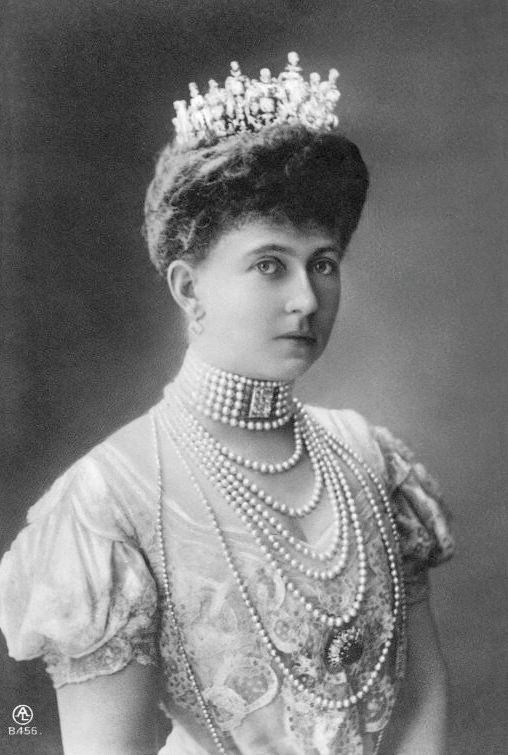 |
| Sophie of Prussia |
As to who was the happiest of the sisters, it would be hard to say. Tragedy struck when one of their brothers died of meningitis before the age of two and another brother died at age 11 from diptheria. Their youth was also marred by interpersonal disturbances in their family. Although their parents, Vicky and Friedrich, loved each other deeply and were happy in their marriage. Friedrich's parents never understood or approved of the intelligent and progressive English princess. This eventually resulted in a kind of split among the children, with the oldest two Wilhelm and Charlotte, often in open conflict with their parents and openly hostile after the death of their father. Meanwhile the youngest three daughters adored Vicky and identified with her English heritage. Vicky called them "my three sweet girls," and left her own beloved home to the youngest one, Margaret. Nevertheless, this early rift in the family continued to cause heartache throughout their lives. Sophie was even banned from Germany for a time because her brother did not like that she changed religions after her marriage.
 |
| Margaret of Prussia |
Even after their marriages, it would be hard to know which of these girls had a better lot. Sophie faced down both the Great War and revolution in her adopted
country, where her status of sister of the German Kaiser drew
unwarranted hatred and fear, despite her brother's hostility toward her. Margaret, who was known as Mossy, had a happy marriage, but
two of her sons were killed in WWI and the other two became Nazis.
In addition to her terrible relationship with their mother, Charlotte had an even more
difficult one with her only child, Feodora, who eventually committed
suicide after a lifetime of misery. Viktoria, who had no children with her
first husband, re-married against her family's wishes. Her scoundrel second husband burned through what little money she had, and practically abandoned her. She was about to divorce him
when she died of pneumonia
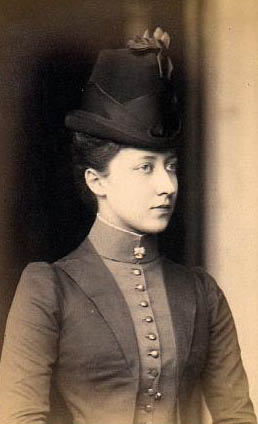 |
| Louise Princess Royal |
The Wales sisters had a much less stressful childhood. Raised in the raucous and somewhat less-disciplined household of the party-hearty Prince of Wales and his Danish wife Princess Alexandra, they grew up surrounded by fun and games and outdoor activities. Queen Victoria did not approve of these goings-on, and the family was referred to as the "wild Waleses."
Their home was not devoid of the kind of tragedies that often touched Victorian-era families. Their baby brother Prince Alexander John died the day after he was born. Then, their beloved eldest brother Prince Albert Victor died of the flu just before his 28th birthday. His death stunned the family and the nation. He left behind a fiancee whom his younger brother dutifully fell in love with and married. (See my post
A Royal Love Triangle for more about that.)
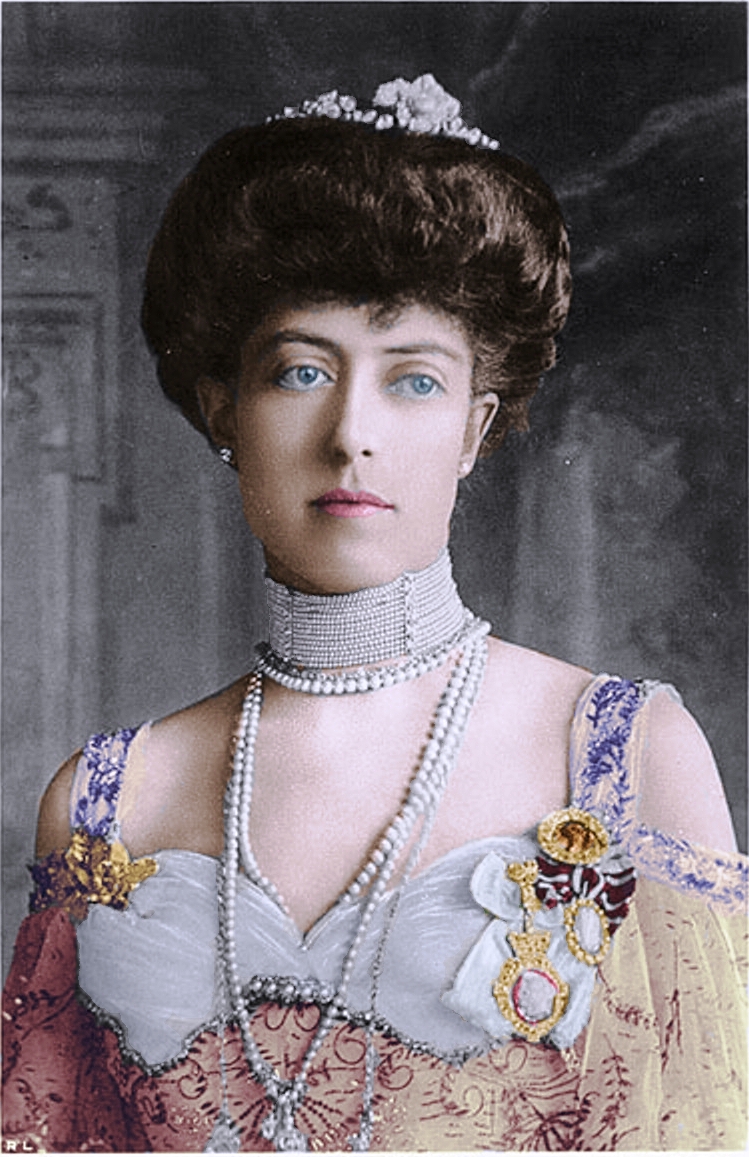 |
| Victoria of Wales |
The three Wales sisters are often considered to be among the least attractive of Queen Victoria's granddaughters. This was quite surprising because their mother was thought to be one of the most beautiful princesses of her day. But Princess Alexandra had a few physical shortcomings that impacted her daughters. First, she had a scar on her neck, which greatly influenced all women of her era. Princess Diana's short, fringed hair caused a sensation in her day, while Alexandra's penchant for high-necked collars and choker necklaces--all designed to hide that scar--rocked the women of the 19th century, including her daughters. Alexandra also had a limp and suffered from increasingly acute hearing problems. This (and perhaps her husband's infidelities) may have contributed to her desire to keep her daughters close to her; so close that middle daughter Victoria never married. Although she could have married the future King of Portugal, Victoria remained Alexandra's companion until her mother's death in 1925. Only then, at the age of 58, was she able to exert a level of independence.
 |
| Maud of Wales |
Louise of Wales married the much older Earl of Fife, who was soon created a Duke by her grandmother Queen Victoria. The couple's first child was a stillborn son, followed by two daughters, who were initially styled as the daughters of Duke but were later made royal princesses when their grandfather became King Edward VII. They are the only female-line grandchildren to have received royal titles in modern British history. Another exception had been made for Louise's girls, when their great-granny Queen Victoria made it possible for the eldest to become Duchess of Fife in her own right after her father's death. Louise was eventually named Princess Royal, a title reserved for the eldest daughter of the British monarch.
The youngest Wales daughter Maud married at age 27, a bit older than the average princess. She selected an unassuming younger son of the Danish royal house. She struggled to have a child, producing only one son. Then, her life was turned upside down when her husband was selected as the first king of the newly independent Norway. Shy Maud never imagined a queenship in her future, and her health suffered in the cold Norwegian winters, leading her to spend considerable time in her native England. On the upside, part of Antarctica was named Queen Maud's Land in her honor.
 |
| Victoria of Hesse |
Several of the Hessian granddaughters are often thought to be among the most beautiful. Unlike their vivacious and earthy mother, Princess Alice, they tended to be a bit shy. This is perhaps because they lost their youngest sister Marie and their mother to typhoid when the eldest Victoria was 15 and the next-to-youngest Alix was only six. (Read about this tragedy in my post
The Kiss of Death.) They also lost their brother Friedrich at the age of two. The first of Queen Victoria's grandsons to be diagnosed with hemophilia, he died of a brain hemorrhage after falling from a second-floor window. After Alice's death, Queen Victoria saw herself as their surrogate mother and all of the Hesse children spent considerable time in England. Victoria took great interest in all of their activities, even after they married and had children of their own.
 |
| Elizabeth of Hesse |
Victoria of Hesse married for love but her choice was a bit controversial. Her husband Prince Louis was one of the famously handsome Battenberg princes, a morganatic branch of the Hessian royal family. Their marriage helped ease the way for Victoria's higher ranked aunt, Princess Beatrice, to marry Louis' younger brother Henry. Louis was in the British navy, and their children grew up more English than German despite their Hessian roots. Louis eventually rose to be Britain's First Sea Lord. However, anti-German sentiment during World War I not only caused him to lose his position but also led him to anglicize the family name to Mountbatten and drop his princely title in exchange for being named the Marquess of Milford Haven. Their oldest daughter Alice married Prince Andrew of Greece and became the mother of Prince Philip Duke of Edinburgh. Their second daughter Louise married the Swedish king while their sons became quintessential English lords, with the youngest Lord Louis Mountbatten serving as the last Viceroy of India and gaining the title Earl Mountbatten of Burma. He and several members of his family were assassinated by the Irish Republican Army in 1979.
 |
| Irene of Hesse |
Assassinations were all too common for this branch of Victoria's family. The two most beautiful of the Hessian granddaughters were assassinated during the Russian Revolution. The youngest and most shy Alix, who became Empress Alexandra of Russia, was first held prisoner with her husband Tsar Nicholas, their four young daughters and their son, Tsarevich Alexei, who has become the most famous hemophiliac in history. The entire family and a few of their devoted staff were murdered together at Ekaterinburg on July 17, 1918. The next day, Alix's sister Elizabeth was killed elsewhere along with several Romanov princes. The execution of the Tsar's family is far more famous, but Elizabeth's death is perhaps more grisly. Beaten and shoved into a pit, Elizabeth and her imperial relatives were still alive. So first one grenade and then another was tossed into the hole. When she could still be heard singing hymns, brush was thrown in and set on fire. Before her death, Elizabeth had become an Orthodox nun. Widowed without children at an early age when her husband Grand Duke Sergei was assassinated by being blown up in the streets of Moscow, Elizabeth had taken to religious life. She, Alix, Nicholas and the five imperial children are now recognized as saints of the Russian Orthodox church.
 |
| Alix of Hesse |
Their sister Irene was considered the least pretty by their mother Princess Alice, but she had a much less turbulent life than her gorgeous sisters Elizabeth and Alix. She married her Aunt Vicky's second son, Prince Heinrich of Prussia. In fact, the couple was among the most popular members of the extended international royal family because they were always so very pleasant and kind. This does not mean that they never suffered, however. Like so many of Queen Victoria's granddaughters, Irene passed the gene for hemophilia to two of her three sons, the youngest of whom died from a bump on his head when he was only four. The first World War separated her from her Russian sisters and the second separated her from her one surviving son, who refused to return to Germany. She disinherited him and settled her estate on his daughter instead. Irene was one of the members of the family to actually meet Anna Anderson, the Polish impostor who famously claimed to be the Grand Duchess Anastasia having allegedly escaped the cellar in Ekaterinburg. Irene knew immediately that Anderson was not her beloved niece and was always deeply troubled by the woman's ongoing claims and notoriety.
 |
| Marie of Hesse |
Three of the four Edinburgh sisters are often included in lists of the Queen Victoria's prettiest granddaughters. Only Princess Alexandra never, ever makes the cut. Through their forceful and imperious mother, the Edinburghs were also granddaughters of the Russian Tsar Alexander II. This means that their mother was an Imperial Highness not a mere Royal Highness like their father and technically outranked him. Queen Victoria however thought all of this was humbug since she was Empress of India, after all, and the British Empire was (of course) the greatest nation on earth. Nevertheless, the less-than-harmonious relationship between Victoria and her Russian daughter-in-law meant that the Queen was not quite as close to her Edinburgh granddaughters as she was to many of the others.This was especially true after their father Prince Alfred Duke of Edinburgh inherited his German uncle's duchy in Coburg and the young family moved to Germany as its primary home. For this reason, these princesses are also often referred to as the Coburgs or Saxe-Coburgs. Their only brother Alfred died under somewhat unclear circumstances; it has been attributed to consumption, syphilis, and suicide.
 |
| Marie of Edinburgh |
The eldest of these princesses, Marie, who was called Missy by the family, is almost always at the top of my list of royal beauties. (I change my mind sometimes.) Married off at the age of 17 to a man she barely knew and shipped off to live on the edge of Europe in Romania under the watchful and jealous eye of her husband's eccentric aunt Queen Elisabeth, Marie grew from a timid girl into a tough and determined advocate for her adopted country. She dutifully bore her husband six children--although many believe that the youngest was the son of her lover. As Crown Princess and later Queen during World War I, she often positioned herself as the patriotic center of her nation's hopes, rallying the troops, inspiring the people, and traveling abroad after the war to raise funds to rebuild the nation. When her oldest son became king and then abandoned the throne, it was Marie who emerged as the symbolic grandmother of the country and the real grandmother of the boy King Michael. Petite with bright blue eyes paired with dark curly hair, Marie was very vain about her beauty and often crowned herself as the most beautiful royal lady. She was also willing to share her thoughts and views like no other royal lady. Her loveliness and candor captivated Americans who liked a Queen with gumption and this attracted financial support for Romania. Her own daughters were a mixed blessing with moody Elisabetha helping to
drag down the Greek throne, marrying and later divorcing Sophie of
Greece's son King George II. Marie's namesake daughter, Marie, married
the King of Yugoslavia, who was assassinated in 1934, leaving the young
Queen to help guide her underage son as a time when the Balkans were
once again falling apart. When WWII finished off their throne, Marie the
younger and her sons fled to Britain. Missy's
youngest daughter married and divorced twice, joined an Orthodox
religious order as Mother Alexandra and eventually founded the Monastery
of the Transfiguration in Pennsylvania. As for Missy's sons, the two
eldest married "inappropriate women" while the youngest died of typhoid as a toddler.
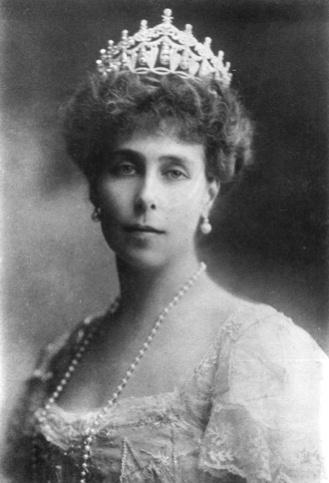 |
Victoria Melita
of Edinburgh |
Missy's taller younger sister, Victoria Melita, known as Ducky was also quite pretty and she also married as she was told--the first time. When her marriage with the Hessian granddaughters' only brother fell apart, Ducky did not do the acceptable and honorable thing expected of her. She divorced him and when their only daughter died of typhoid, she cut all of her ties with Hesse. Soon thereafter, she married the Tsar's cousin Grand Duke Kyril Vladimirovich without the Tsar's permission. The controversial couple spent their first married years in exile in Paris before finally being allowed back in Russia. When the revolution came, her husband hoped to save the monarchy by swearing his allegiance to the Duma but this failed, and the pregnant Ducky with her husband and two young daughters escaped across the Finnish border. After the Tsar's assassination, Kyril declared himself head of the family and claimant to the throne. When he died, Ducky clung to this claim for their son Grand Duke Kyril Vladimirovich, whose daughter Grand Duchess Maria Vladimirovna is now one of the Romanov claimants. Ducky was initially buried in Coburg but her body was moved to Russia after the fall of the Soviet Union.
 |
| Alexandra of Edinburgh |
The least attractive Edinburgh sister also had the least exciting life. As with her sisters, her mother pushed Princess Alexandra into an early, loveless marriage. Alexandra obediently complied and didn't raise a ruckus by taking lovers or divorcing her husband. Instead she gave him five children and became even more thoroughly German as the Princess of Hohenlohe-Langenburg. Her youngest child died in infancy. Her oldest daughter married a German prince and her oldest son married an older sister of today's Duke of Edinburgh. He did cause a bit of stir, however, by first becoming engaged to Gloria Morgan Vanderbilt and then giving testimony in the notorious custody battle of over her daughter Gloria Vanderbilt (the mother of Anderson Cooper.) Like her husband and son, Alexandra joined the Nazi party but she did not live to see that party's downfall at the end of WWII.
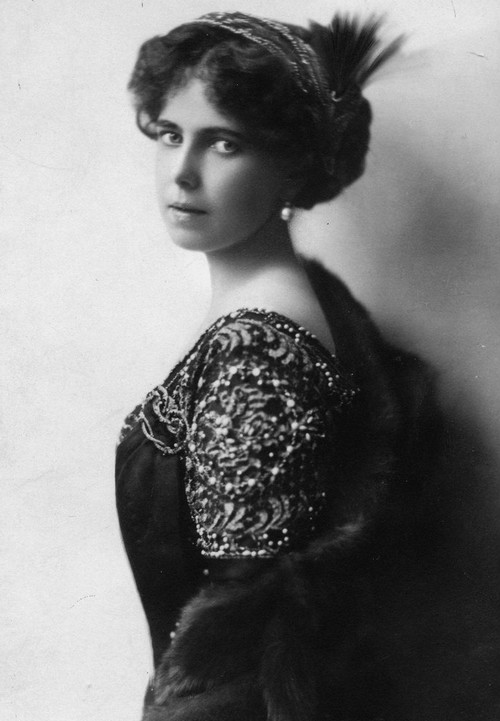 |
| Beatrice of Edinburgh |
One of Queen Victoria's youngest granddaughters, Beatrice of Edinburgh was born in 1884, nearly six years after her nearest sister. For some reason the granddaughters born in the 1880s--all from different parents--are among the most beautiful. Somehow, Beatrice was spared her mother's overwhelming pressure to marry young although her heart led her to begin a young romance with Tsar Nicholas II's younger brother, Grand Duke Michael Alexandrovich. The Tsar forbade the marriage just as he had done with her sister Ducky, and for the same reason--they were too closely related for the Orthodox church. Beatrice did not follow the same path as Ducky, however. Although heartbroken, she ended the romance and instead traveled to ease her broken heart. When her cousin Ena (see below) married the Spanish king, Beatrice finally recovered when she met the Spanish Prince Alfonso de Orleans y Borbon. This time, when the Spanish king objected--this time because Beatrice refused to convert to Catholicism--she married her chosen groom any way and lived in exile for the first few years, moving to Spain at last in 1912. A year later, she converted. Her marital choices had spared her from the Russian Revolution but not from the Spanish Civil War, which claimed most of the family's fortune and the life of one of her three sons.
 |
Helena Victoria of
Schleswig-Holstein |
Like the Wales sisters, the two Schleswig-Holstein princesses are also thought to be among the least attractive of Victoria's granddaughters. However, they were very popular among the extended family and were considered members of the British Royal Family, despite their Germanic origins. Queen Victoria liked to keep her daughters close to her whenever possible, so when her daughter Helena married a minor Germanic princely, Victoria gave him a job as Ranger of Windsor Great Park, and their children grew up there on the grounds of that most historic English castle. When the extended British Royals dropped their Germanic surnames and titles, these two simply became Princess Helena Victoria and Princess Marie Louise (of nowhere in particular). Their brothers' stories were more complicated. The two youngest boys died as infants. The oldest brother Prince Christian Victor maintained his British ties, and served with the British Army in the Boer War, contracting malaria and dying of typhoid at the age of 33 having never married. The second brother Prince Albert went to Germany in preparation for becoming the Duke of Schleswig-Holstein. He served in the German army although the Kaiser excused him from fighting against the British in World War I. He became Duke in 1921 and died in 1931, never having married to secure heirs for the title. However, he did father an illegitimate daughter, who was raised in Germany by Jewish foster parents. During World War II, when she wished to marry a German noble, the Nazis presumed she was Jewish and would not allow her until her father's sisters gave testimony as to her true parentage. Always charitable and honorable, Helena Victoria and Marie Louise did not hesitate to claim their illegitimate niece.
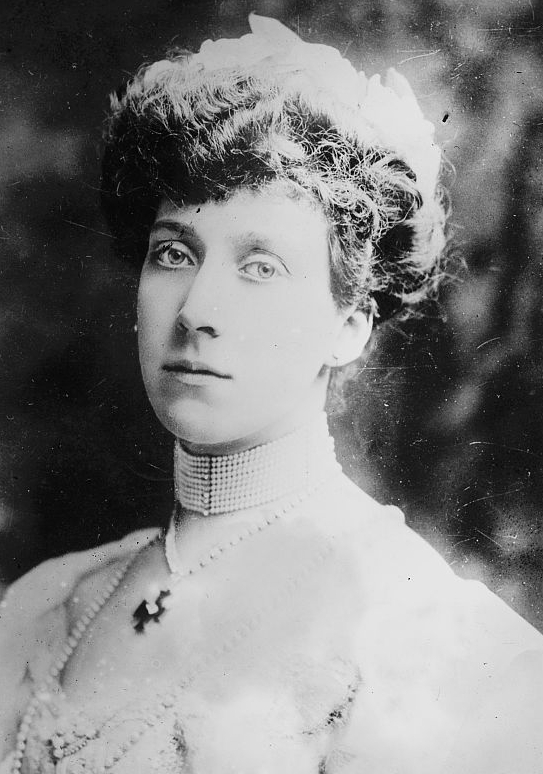 |
Marie Louise of
Schleswig Holstein |
Older than her sister by just two years, Helena Victoria lived long
enough to attend the wedding of Queen Elizabeth II in 1947 while Marie
Louise survived to attend the Queen's Coronation in 1953. Both of them
were devoted to numerous charitable causes including the YMCA, YWCA and
various nursing organizations. Marie Louise even adopted a Wolf Cub
Pack. Unlike her sister, Marie Louise did marry. At 19, she agreed to a marriage arranged by her cousin Kaiser Wilhelm to Prince Aribert of Anhalt. It was a miserable coupling (it has been asserted that he was gay) and they had no children. Nevertheless, they stayed together for nine years until, without Marie Louise's permission or even knowledge, her father-in-law used his prerogative as reigning Duke of Anhalt to annul the marriage. The princess, however, believed her vows to be indissoluable, so she never married again. This doesn't mean she wasn't happy to be rid of him. Reading her memoir,
My Memories of Six Reigns, remains on my bucket list...so, if anyone is wondering what to get me for Christmas...
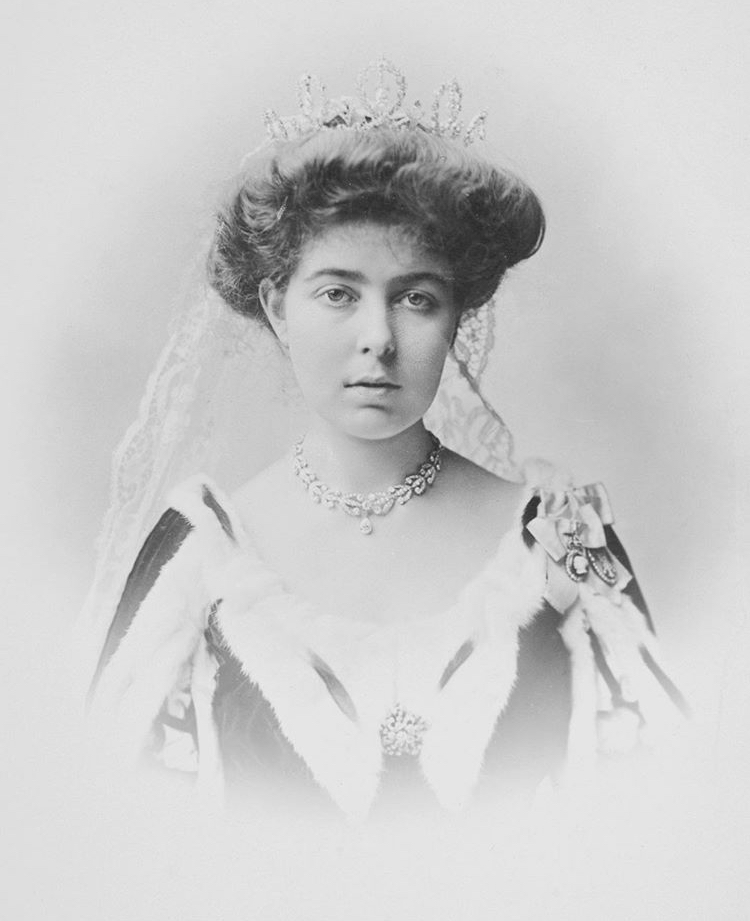 |
| Margaret of Connaught |
The first of those 1880s granddaughters, Margaret of Connaught, known as Daisy, and her younger sister Princess Patricia were considered among the most eligible princesses of their day. When their parents took them to Portugal, everyone hoped that meant one or both of them would marry Portuguese princes, but the girls weren't interested. Like many of their cousins, Daisy and Patsy, were determined to make their own marital matches. When Margaret fell in love with the Crown Prince of Sweden during a holiday in Egypt, people were delighted. The artistic and athletic princess quickly won popularity in her new land, as much for her personality as for producing five children in ten years. Her only daughter Ingrid later married the Danish king and her oldest son died in a plane crash never having become Crown Prince much less king, and passing the throne instead to his son, the current King Carl XVI Gustav. Her other three sons followed their hearts into relationships with "unequal" partners. Two of them married their "lesser" brides without royal permission and lost their royal rank. Prince Bertil, however, lived with his Welsh-born love without marrying her for nearly 30 years until his nephew became king and allowed her to become Princess Lilian.
 |
| Patricia of Connaught |
Crown Princess Margaret served as an intermediary between her extended family members living across enemy borders during WWI, passing letters and assistance. Her numerous charitable activities during the war and her strong support for full democracy after the war helped preserve the Swedish monarchy. Tragically, however, she never became Queen. Heavily pregnant with her sixth child, she died suddenly at the age of 38 from a failed operation to relieve an infection behind her ear. The infant did not survive. Sweden was plunged into deep mourning. Three years later, the Crown Prince married her cousin's daughter, Lady Louise Mountbatten, who became a stepmother, but never had children of her own.
Margaret's sister Patsy also married a man of her choosing, but only after traveling quite a bit with her parents, spending two years in India and several more in Canada, where a lake and a regiment are named for her. Despite numerous royal matches being suggested for her, Patsy chose instead to marry The Hon. Alexander Ramsay when she was 32. She also voluntarily dropped her royal title, although not her membership in the royal family or place in the succession. She gave birth to her only son within the year, and her daughter-in-law, Lady Saltoun is still considered a member of the British Royal Family. (UPDATE: Lady Saltoun died in 2024.)
Unlike all of their royal cousins, Daisy and Patsy experienced no difficulties or heartaches because of their brother. Prince Arthur happily married their cousin Louise Princess Royal's oldest daughter, served as Governor General of South Africa, and fathered his required heir.
 |
| Alice of Albany |
Perhaps the "plainest" of the lovely 1880s granddaughters, Princess Alice of Albany's life was touched by tragedy when her father, the hemophiliac Prince Leopold died when she was still an infant. (Read her mother's story in my post
Young Royal Widows.) And again, when her only brother was separated from the family to go to Germany where he succeeded his uncle The Duke of Edinburgh as the boy Duke of Saxe-Coburg and was officially made a persona non grata in their homeland during the first World War. And again when her youngest son Maurice died as a baby. And yet again when her other son died in a car accident at age 21. Nevertheless, Alice was a trooper. She was a well-respected member of the British Royal Family, dying only months before the wedding of Charles and Diana. Alice solidified her ongoing ties within the family by marrying the future Queen Mary's brother, Prince Alexander of Teck. During the great name change of 1917, they adopted his mother's family's ducal title as their surname and became the Cambridges. He was later made Earl of Athlone. Their only daughter, Lady May Cambridge included a five-year-old Princess (later Queen) Elizabeth among her bridesmaids when she married Sir Henry Abel-Smith.
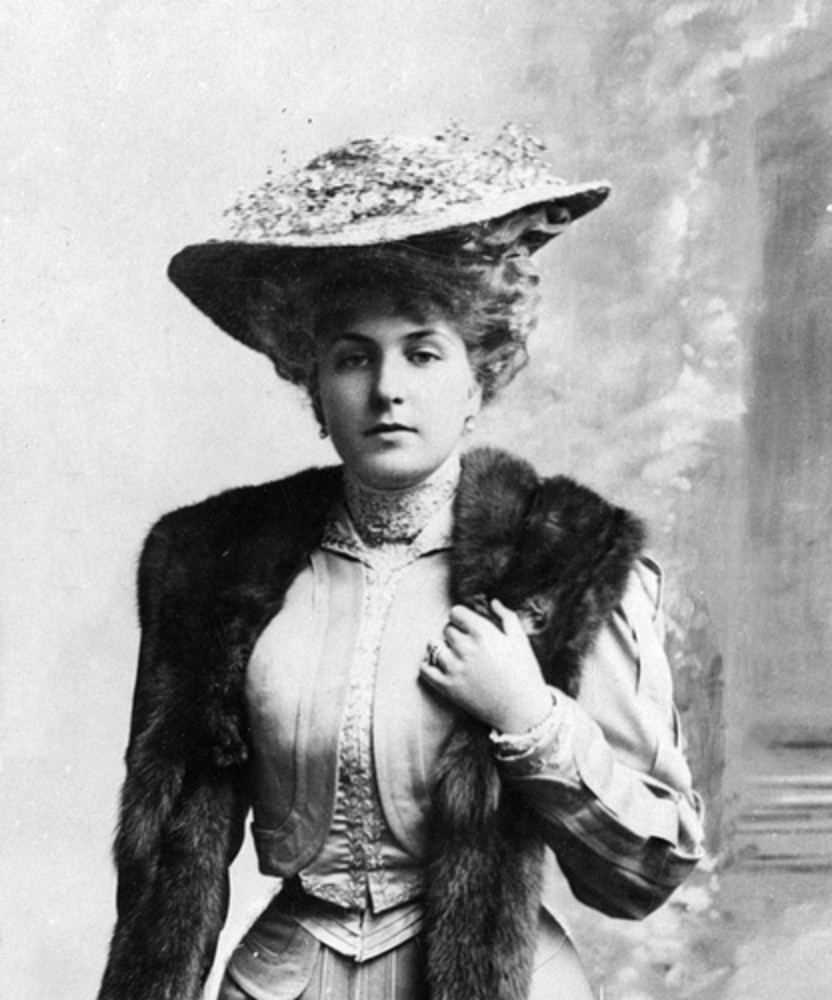 |
| Victoria Eugenie of Battenberg |
Rounding out our 1880s girls, the only daughter of Victoria's youngest daughter Beatrice is often at the very top of people's lists of most beautiful granddaughters. Born in 1888, Princess Victoria Eugenie of Battenberg, called Ena, was the youngest granddaughter and the only one actually raised in the Queen's own household although others lived nearby on the various estates or visited quite frequently. After the Queen's death in 1901, the teenaged princess moved into Kensington Palace with her mother and three brothers.
Like so many of her cousins, Ena's life was touched by many tragic losses. Her father died on his way to serve in the Boer War when she was eight. Her youngest brother was killed in action in World War I and her hemophiliac brother Leopold died during a hip operation. Her wedding day with her beloved King Alfonso XII--who many people thought would marry her cousin Patsy--was marred by a deadly bomb attack on the carriage procession. When she passed the hemophilia gene to two of her sons, they both died in minor car accidents. One of her other two sons was deaf. With her marriage deteriorating even faster than the Spanish political situation, the couple made no pretense of living separately when they were forced into exile by the Second Spanish Republic ahead of the Spanish Civil War. (Read more about that in my post
Death to the Queen.) Ten years later, her husband died of a heart attack. Soon thereafter, she was forced to abandon her new home in Italy because she was too pro-Allies in World War II.
The Spanish throne was finally restored to her grandson King Juan Carlos. Victoria Eugenie returned to Spain briefly in 1968 to attend the christening of her great-grandson, Spain's new King Felipe.


_(April_12%2C_1866_%E2%80%93_November_13%2C_1929).jpg)


















It wasn't Prince Arthur who was the Duke of Edinburgh. It was Prince Alfred.
ReplyDeleteIt wasn't Prince Arthur who was the Duke of Edinburgh. It was Prince Alfred.
ReplyDeleteThanks! I always want to make Arthur older! It has been corrected.
DeleteMy what Beautiful Princess's! I could never pick one over the others! Thank You for these Pictures!!
ReplyDeleteI want to to thank you for this fantastic read!! I definitely loved every bit of it. I have got you saved as a favorite to check out new things you post…
ReplyDeleteI have often heard Princess Margaret of Connaught was considered one if the most beautiful also
ReplyDelete